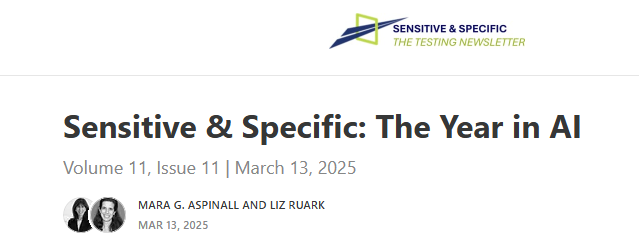The newsletter "Sensitive and Specific" is worth tracking for frequent lab industry updates and insights.
I especially enjoyed their new issue, "AI Year in Review," covering a wide range of topics in the clinical lab, imaging, and beyond.
Find it here:
https://sensitiveandspecific.substack.com/p/sensitive-and-specific-the-year-in
It seemed appropriate to try an AI review of the special issue.
###
AI Corner
###
The 2024 AI Explosion in Diagnostics: Hype, Hope, and Hard Questions
The latest issue of Sensitive and Specific is a fitting encapsulation of 2024—a year in which AI didn’t just enter the diagnostic landscape; it steamrolled through it. The sheer breadth of developments covered in this special issue reinforces a point many in the molecular and diagnostic industries have sensed for some time: AI is not a tool of the future; it is the present.
While AI has already transformed radiology and imaging, the newsletter rightly highlights how digital pathology and patient-reported data analysis are rapidly gaining traction. The next challenge isn’t technical capability—it’s proving scalability, achieving physician buy-in, and navigating the regulatory maze. The comparison to the early days of genomic testing is apt. AI’s biggest barrier isn’t whether it works (it does); it’s whether clinicians trust it enough to change their workflows and decision-making.
AI Across Diagnostics: A Tipping Point?
The special issue lays out an impressive collection of real-world AI applications, from predicting pancreatic cancer 475 days before diagnosis to guiding ultrasound exams for non-specialists with expert-level accuracy. Some highlights:
- Cancer detection: AI-assisted colonoscopy improved polyp detection by 40%, and AI-enhanced CT scans identified pancreatic tumors over a year earlier than standard screening.
- Cardiology: Deep learning models can now diagnose coronary artery disease from retinal images—a development that could shift how we think about non-invasive screening.
- Mental health & neurology: AI-based speech analysis is making strides in depression diagnosis, and machine learning models are showing promise in Alzheimer’s prediction.
And yet, the issue also captures AI’s limitations—notably, that AI doesn’t always improve radiology accuracy and that many AI-powered diagnostic tools remain uncovered by insurance.
Beyond the Hype: The Policy and Adoption Questions
The special issue smartly recognizes that AI’s greatest challenge is no longer whether it works—it’s how we integrate it responsibly into healthcare. The final section highlights:
- Regulatory shifts: HHS now requires AI vendors to disclose training data—a crucial move for transparency and bias reduction.
- Liability and reimbursement: Who is responsible when an AI-assisted diagnosis goes wrong? Will insurers pay for AI-enhanced diagnostics? These questions remain unanswered.
The Genie is Out of the Bottle
Perhaps the most important takeaway from this issue is that AI’s role in diagnostics is no longer theoretical. From early cancer detection to AI-driven sepsis prediction, 2024 cemented AI as an indispensable part of the diagnostic ecosystem. The wait-and-see approach that once applied to genomics is now being tested again, this time with AI. If history is any guide, those who embrace AI early will define the future of diagnostics.
For molecular and diagnostics professionals, this issue of Sensitive and Specific is required reading—not just to understand AI’s current capabilities, but to prepare for the seismic changes still to come.
